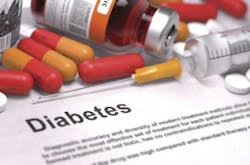Statistics show that the percentage of new-onset type 2 diabetes cases in adolescents has risen significantly. Just a decade ago, type 2 diabetes in adolescents constituted less than three percent of new adolescent cases, globally. Today, the percentage of new adolescent cases of diabetes that are classified as type 2 is 45 percent and continues to rise.2
Less than 100 years ago, type 1 diabetes meant certain and often rapid death. Children with diabetes often died within weeks; adults with type 2 diabetes were fortunate to live 10 years after diagnosis, and many died much sooner. With the introduction of insulin to treat diabetes in 1922, individuals with diabetes were able to live longer and more productive lives. However, especially when not controlled properly, complications from diabetes continue to cause blindness, kidney failure, non-traumatic lower limb amputation, shock, coma, and death. Clearly, the laboratory’s role in helping physicians and patients diagnose and manage diabetes has never been more critical.
Fasting glucose versus HbA1c testing
With type 1 diabetes mellitus, the body does not produce insulin. Complications can be sudden and dramatic. With type 2 diabetes mellitus, the body produces insulin but, over time, cells in the body no longer respond properly to it. The pancreas may continue to make insulin for some time, or may eventually stop production altogether.
The diagnosis of diabetes, as well as evaluation of the type and severity, are critical to the proper management of treatment to prevent the onset or progression of serious complications. The definitions of what constitutes diabetes are more laboratory-based than ever before; as the incidence of disease continues to grow, symptoms alone (such as excessive thirst or frequent need to urinate) are not definitive, and diagnosing and treating the disease in its earliest stages can dramatically lower a patient’s risk of developing more advanced diabetes and its attendant complications.
The two most prevalent diagnostic tests used today are the fasting plasma glucose (FPG or “glucose”) test and the hemoglobin A1c (HbA1c) test. Debates have been ongoing for some time about which test is best for an accurate diagnosis of diabetes and ongoing diabetes monitoring. The answer is: both. It is important to understand what each type of test measures and how to properly employ each test to help diabetes patient management.
FPG testing measures short-term glucose metabolism—blood sugar levels at a given point in time. Fasting for at least eight hours prior to testing is critical, as baseline glucose, not postprandial, needs to be measured. An FPG of less than 100 mg/dL is considered normal; of 100 to 125 mg/dL is considered prediabetes; 126 mg/dL and above means the patient has diabetes.3
HbA1c is a measure of longer-term glucose metabolism. Glucose in the serum reacts with an amino acid group on hemoglobin to form glycated hemoglobin. Hemoglobin A1c is defined as that product of reaction of glucose with the N-terminal amino acid of the hemoglobin beta chain. Hemoglobin A1c results are expressed as a percentage of total hemoglobin. Individuals with HbA1c levels of less than 5.7 percent are considered normal; levels of 5.7 percent to 6.4 percent are considered prediabetic; and levels ≥ 6.5 percent HbA1c are diagnostic of diabetes.3
Pros, cons, and best practices
FPG is inexpensive and globally available, and it is a standard part of a routine blood panel. Because FPG measures short-term glucose metabolism, it works well for management of acute episodes; and because it is inexpensive, it is the most appropriate first test to indicate the potential presence or future risk of diabetes. However, as noted above, the fasting component of the test is crucial—and sometimes problematic. A patient may say he or she has fasted for eight hours, but mean “except for the sugar I put into my tea and one slice of dry toast so I could take my medicines this morning.” In addition, factors such as stress, exercise, and acute illness can impact readings on any given day.
HbA1c is not impacted by fasting, stress, or exercise and it can be done with a sample taken at any time (non-fasting). It is an indicator of average glucose concentrations over the last 80 to 90 days. HbA1c values are generated using an assay standardized to an international reference material that gives a clear picture of the body’s average glucose over time. However, it is more expensive than FPG, so it may not be as readily available in less developed or affluent parts of the world. In addition, HbA1c results can be affected by an altered lifespan of erythrocytes and by the presence of hemoglobin variants. In vitro, most assays are not affected by common hemoglobinopathies (HbS, HbC, HbD, etc.), but these hemoglobinopathies and other conditions can affect in vivo red cell lifespan, which will impact HbA1c interpretation. In addition, conditions that decrease average erythrocyte lifespan can cause apparentincreases in HbA1c levels.
Both FPG and HbA1c tests are important in patient diagnosis and management of diabetes, and both should be performed in initial evaluation when a physician suspects that a patient has a high risk of diabetes. For example, a patient who is obese and who experiences frequent urination, excessive thirst, and blurred vision or headaches, should undergo FPG and HbA1c testing to determine if diabetes is present. Once a diagnosis has been made, FPG or, in some cases, non-fasting glucose plasma is the most appropriate test for diabetic treatment episodes, giving physicians and patients quick results regarding the current blood glucose state. (Non-fasting glucose is indicative of acute hypoglycemic or hyperglycemic episodes and is especially important for managing acute episodes so that patients do not have to wait and fast for eight hours before testing.)
The American Diabetes Association (ADA), the Endocrine Society, and the World Health Organization (WHO) have all endorsed the use of HbA1c in the screening and diagnosis of diabetes. In the ADA’s 2010-2013 Standards of Medical Care in Diabetes,4 HbA1c testing is recommended twice yearly in diabetes patients who are stable and meeting treatment goals, and quarterly for diabetes patients who need closer monitoring. Non-diabetics with high risk factors for diabetes (overweight, lack of exercise, hypertension, family history of diabetes, etc.) or who are over age 45 can all benefit from HbA1c testing, repeated at three-year intervals if normal.
Despite the widespread medical and scientific acceptance of the validity of HbA1c, it is not a replacement for FPG. Both tests have pros and cons to their use, and both tests provide physicians and patients with critical information—either regarding short-term or long-term glucose concentrations—that can help patients to delay or avoid serious complications.
References
1. Centers for Disease Control and Prevention. National Diabetes Statistics Report: Estimates of Diabetes and Its Burden in the United States, 2014. Atlanta, GA. U.S. Department of Health and Human Services; 2014.
2. D’Adamo E, Caprio S.Type 2 diabetes in youth: epidemiology and pathophysiology. Diabetes Care. 2011; 34 Supplement 2, S161-S165;doi:10.2337/dc11-s212.
3. Diagnosis and classification of diabetes mellitus, Diabetes Care 2013; 36 Supplement 1, S67-S74; doi:10.2337/dc13-S067.
4. Standards of medical care in diabetes. Diabetes Care. 2013; 36 Supplement 1, S11-S66; doi:10.2337/dc13-S011.
About the Author

Jack Zakowski, PhD, FAACC
is Principal of IVD Consulting, LLC and chaired the development of CLSI C56A, Hemolysis, Icterus, and Lipemia/Turbidity Indices as Indicators of Interference in Clinical Laboratory Analysis.He has served in governance positions with AACC, is Past President of CLSI, and is currently Chair of ISO TC212 Clinical Laboratory Testing and in vitro diagnostic Test Systems.


